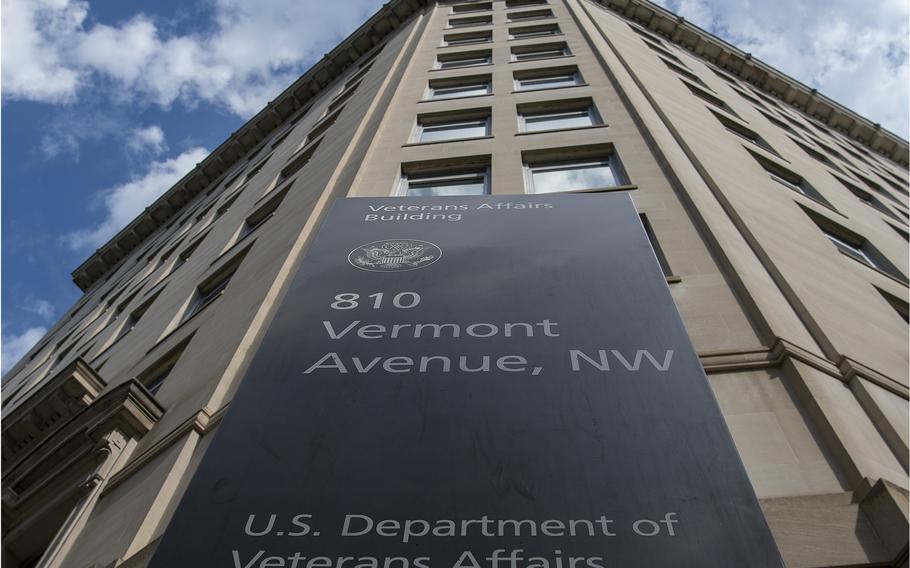
The Department of Veterans Affairs headquarters building in Washington, D.C. (Carlos Bongioanni/Stars and Stripes)
WASHINGTON — Hospitals at the Department of Veterans Affairs lag behind commercial hospitals in access to life-changing medical technology because of budget constraints and staffing shortages, leaders of medical technology companies told lawmakers Tuesday.
VA’s reliance on outdated technologies stems from unpredictable budget cycles and a lack of trained personnel to operate lifesaving technology, said Will Gray, vice president at Boston Scientific, a global medical technology company.
Gray and other leaders from medical technology companies spoke at a House Veterans’ Affairs Committee oversight hearing that looked at recent medical innovations that are yielding promising outcomes and extending lives.
But Rep. Mark Takano, D-Calif., sharply criticized Republican leaders at the start of the hearing for not including VA representatives to discuss challenges in adopting innovative medical devices.
“Without VA’s presence, we will not be able to hear about the on-the-ground reality, about the actual need for these devices,” Takano said.
Rep. Sheila Cherfilus-McCormick, D-Fla., echoed Takano’s comments about the absence of VA representatives at the hearing.
“It is important to have the VA here so they can talk about the infrastructure and procedures they have in place,” she said. “What we are looking at is a standard of care that veterans are being denied.”
Gray discussed advances in treating atrial fibrillation — commonly known as AFib — and preventing strokes that he said VA hospitals have been slow to adopt.
Boston Scientific has developed a non-thermal treatment for atrial fibrillation that uses pulsed electrical fields to disrupt faulty heart signals while protecting surrounding tissues. The company also has developed a minimally invasive implant that prevents blood clots from forming and reduces the risk of strokes.
In 2025, more than 60% of all AFib procedures in commercial hospitals use pulsed field ablation technology. But only 10% of VA hospitals have access to this technology, he said.
Rep. Jack Bergman, R-Mich., asked about the reasons for the difference.
Gray said “budget uncertainty” led to delays by VA hospitals in making purchases after the technology became widely available and the standard for care.
“This gap is not due to lack of clinical interest or demand, but instead stems from budget unpredictability, staffing challenges and procurement inefficiencies. We must modernize these processes to ensure veterans have access to the same life-saving advancements as civilians,” Gray said.
He also said the VA would benefit from a more predictable budget and acquisition process, which would allow for timely adoption of medical technology.
“The VA’s capital allocation process is often fragmented and reliant on short-term budget solutions,” Gray said.
Staffing shortages in procurement aggravate the challenges, leading to purchasing delays, he said. Gray recommended the VA create a “fast-track solution” for adopting high-impact medical technologies.
Devices developed by Philips are common at VA hospitals, including heart monitors, ultrasound and magnetic resonance imaging, or MRIs, said Jeff DiLullo, executive vice president and chief regional leader of Philips North America, which has a medical products division.
Lawmakers need to ensure VA has the funds, tools and capabilities “to deliver the best possible care, as quickly as possible” to veterans, said DiLullo, a former Army Ranger and a graduate of the U.S. Military Academy at West Point, N.Y.
Bergman said it would be appropriate for the Defense Department and VA to work collaboratively in adopting medical technologies.
Philips recently pioneered the Rapid Analysis of Threat Exposure technology, which uses artificial intelligence to detect early warning signs of infectious disease.
RATE technology uses off-the-shelf wearable devices, such as a watch, to monitor more than 150 different vital signs and biomarkers to identify physiological changes that might indicate infection.
DiLullo said the company is running a pilot with 11,000 participants in the Defense Department. He said RATE technology has been able to detect infections in service members before symptoms appear. The company has been collecting biomarkers from service members to advance the technology.
“By providing early alerts, Philips RATE helps to contain the spread of diseases, ensuring better health outcomes and enhancing military readiness,” he said. “In a military context, Philips RATE can digitize the health of our military force, giving battlefield commanders the ability to see the health and fatigue status of the warfighters, which ultimately leads to a more lethal military force.”
DiLullo said the technology could be applied to VA hospital settings.
He also said the company is looking at ways to modernize the VA and improve outcomes at its hospitals and clinics.
For example, he said the VA runs separate and independent radiology departments at each hospital that rely on their own expertise and staffing levels. But creating a centralized network that connects all VA radiology departments would allow facilities to share resources and expertise, ensuring a more consistent standard of care.
Philips offers a radiology operations command center that brings together imaging experts and technologists from various VA locations to work collaboratively, DiLullo said.
“This FDA-cleared remote scanning platform allows radiological specialists in a central command center, located at a VA medical center, to connect with technologists operating imaging machines in real time,” he said.
DiLullo said the VA would benefit from modernizing its imaging infrastructure to enable seamless data sharing across facilities, the Defense Department and clinicians within the community care network.